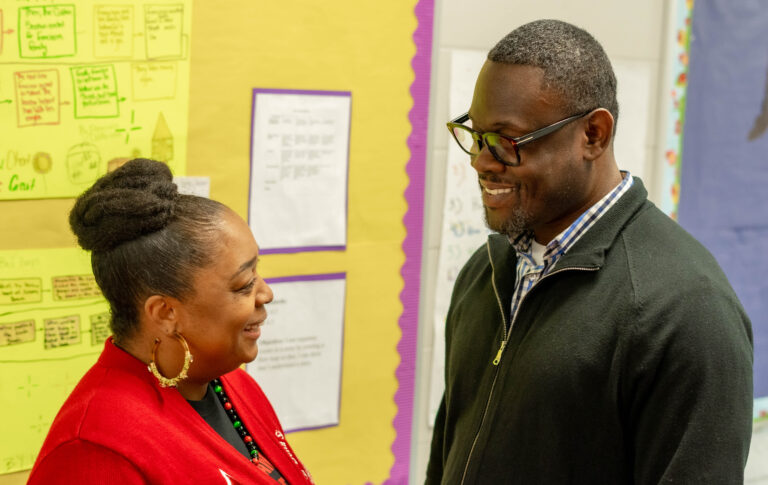Around the time I transitioned from assistant principal to principal within my school, I had coffee with a friend. He asked me about my plans for my first day with staff in August. I recited my draft agenda, starting with the vision and mission roll-out, a few staff culture activities to add some fun, and an overview of our roadmap for the year to meet our goals.
“That all sounds great,” he replied. “But how will your staff know you?” I reminded him this staff knew me already, and that I had hired most of them over the last several years. “Right,” he replied steadily. “But you’re not their AP anymore. Being the principal means something different – and they should hear why you’re the right leader for this moment and why it matters to you.”
Why Vulnerability in Leadership Matters
I thought about his push for weeks. I so desperately wanted to stick to the basics and technicalities, believing my strengths lay in my planning and attention to detail. I was hoping to “wow” my staff with our new minute-by-minute systems and crystal-clear roles and responsibilities for support staff. Still, his feedback felt meaningful, and I knew I needed to inspect my discomfort in the face of it. Why was the idea of sharing myself with my staff so scary to me?
For one, vulnerability requires courage, and is commonly misunderstood as opposition to strength. Because leaders are relied upon for answers and solutions, many mistake any level of personal sharing as a threat to the powerful image they’re otherwise looking to project. As a novice principal, this was the root of my pushback. If I shared too much or showed too much emotion, I was sure it would affect their willingness to respect me as their new leader.
Yet research suggests that vulnerability is the primary factor in the development of trust between a leader and their employees. (Nienaber et al., 2015) Authenticity operates alongside it.
Luthans and Avolio (2003) suggest that authenticity in leadership is a critical factor in transformation, and in light of ever-evolving conditions. They clarify that authentic leaders are led by values grounded in what is right for the community. Further, authentic leaders are aware of and open to discussing their own vulnerabilities with their followers. According to their Authentic Leadership Development Model, a leader’s understanding of where they came from and who they are operate as critical antecedents in the journey to self-awareness and subsequent authenticity.
What a Vulnerable Leader Looks Like
Clearly, vulnerability is worth the effort. So what should leaders do with this knowledge? What can one share with staff to achieve vulnerability and authenticity, and build trust? The guiding questions below can support a new leader as they consider their introduction to staff, or a returning leader as they reset and reflect on a new year:
- How and when did you know you wanted to teach?
- How and when did you know you wanted to lead?
- What life experiences or events shaped your outlook on why this work matters?
- What have you learned about yourself as a leader in your career thus far?
- What calls you to lead at this school, at this moment?
- What are your defining values you’ll use to make difficult decisions?
- What can staff expect from you? How will you show up for them? For students?
As leaders reflect on their answers, they’re encouraged to find depth and truthfulness in their reflections. Additionally, leaders can use visuals (i.e. pictures, artifacts) to support their story-telling, so staff can visualize the journey as it’s shared.
After working through my discomfort, I started my first day as a principal by sharing my more personal journey. I shared early defining moments in my childhood. I connected those moments to my path to educational leadership, which included my sister’s difficulties in school, how they impacted her identity and the rest of our family, and how it took years before her confidence in herself was restored. I shared my values in ensuring every one of our students sees themselves as a learner with limitless potential, and the commitment to restore faith in students who may have lost sight. And I choked up a little along the way, too. So when I moved to school vision, mission, and goals, my staff understood they were being led by someone with purpose and conviction – and they knew why. My initial vulnerability and willingness to share shifted the way the rest of the day resonated.
For years thereafter, staff reflected my vulnerability back to me. Many told me explicitly that they saw me differently – that they appreciated knowing me more deeply. Beyond that, they reflected it back in their trust through roadblocks and new ideas. They reflected it back in their own sharing of self, allowing me to understand them better as we worked together and found a collective purpose for our students. As an Associate with CT3, I now have the privilege of supporting each of my leaders in writing and sharing their own story as they prepare to welcome back their school teams. To this day, despite the discomfort that may exist in the process, each leader later shares the immediate impact they felt in the room, and why it was worth it.
References:
Nienbar, Ann-Marie, et al. Vulnerability and Trust in Leader-Follower Relationships. A Journal of People, Work, and Organisations, 2015.
Luthans, Fred and Bruce Avolio. Authentic Leadership Development. Berrett-Koehler Publishers, 2003.
by Meaghan Loftus, Director of Partner Success
Check out CT3 Education programs such as No-Nonsense Nurturer, Real Time Teacher Coaching, and Real Time Leadership Coaching to find out more about Professional Development for Teachers and Leaders, classroom management strategies, and building relationships with students and their families, and properly addressing important issues in the classroom and school.
Category: Coaching, Education, Leadership, No-Nonsense Nurturer, Real Time Leadership Coaching


